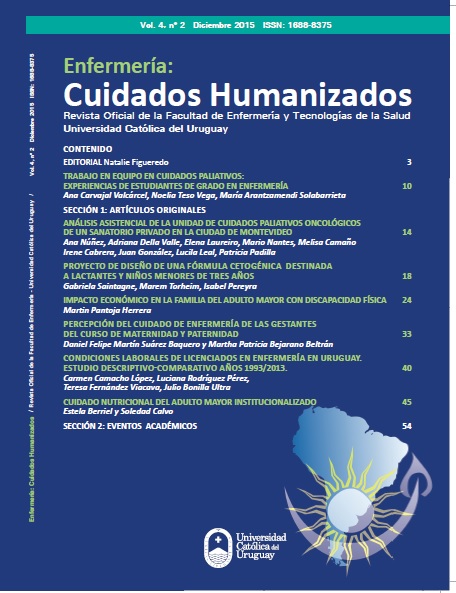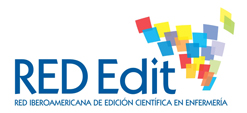PRO JECT OF A KETO GENIC DESIGN FORMULA INTENDED FOR INFANTS AND CHILDREN UNDER THREE YEARS OF AGE
DOI:
https://doi.org/10.22235/ech.v4i2.886Keywords:
Ketogenic Diet, Formulated Food, Lactating, Infants.Abstract
The purpose of this paper is to develop of a ketogenic food formulated for infants and children up to 36 months of age requiring a Ketogenic Diet. The proposed specific objectives
were, firstly, to cover the energy and protein requirements for children under 6 months of age requiring this diet. Secondly, to design the formula so that it can be used in different proportions, according to the need of each patient. Thirdly, to ensure that the formula is accessible from the socio-economic point of view. The methodology used was to conduct a literature research on this topic considering different sources: written literature, virtual libraries and academic websites. The Bromatological National Regulations were taken into account, interviews with several persons involved were conducted, and also a survey of
similar products was carried out together with the study of their nutritional composition. The new product is designed based on three modules (fats, proteins and carbohydrates) one for each macronutrient, that combined generate the right ketogenic ratio and allow to correctly calculate the energy-protein needs of the target population. The micronutrient will be supplied separately according to the age requirement, as is common practice in the implementation of this diet. The proposed formula was designed to be produced locally because their ingredients are available domestically and their costs are accessible.
Downloads
References
(1) Nordli D, Kuroda M, Carroll J, Koenigsberger D. Experience with the ketogenic diet in infants. Pediatrics. 2001 Jul; 108: 129-133.
(2) Klepper J, Leiendecker B, Bredahl R, Athanassopoulos S, Heinen F, Gertsen E, et al. Introduction of a ketogenic diet in young infants. J. Inherti Metab Dis. 2002 Oct; 25(6): 449-460.
(3) Hong A, Turner Z, Hamdy R, Kossoff E. Infantile spasms treated with the ketogenic diet: Prospective single-center experience in 104 consecutive infants. Epilepsia 2010; 51(8): 1403-1407.
(4) Cusmai R, Martinelli D, Moavero R, Vici C, Vigevano F, Castana C et al. Ketogenic diet in early myoclonic encephalopathy due to non ketotic hyperglycinemia. Eur. J of Pediatr. Neurol. 2012; 16: 509-513.
(5) Pires M, Ilea A, Bourel E, Bellavoine V, Merdariu D, Berquin, P, et al. Ketogenic diet for infantile spasms refractory to first-line treatments: An open prospective study. Epilepsy Res. [Internet] 2013 [citado 24 Jun 2013]; Disponible en: http://dx.doi.org/10.1016/j.eplepsyres.2012.11.009
(6) Espinoza, C. Dieta Cetogénica en Pediatría. En: Sanjurjo, P, Baldellou, A. Diagnóstico y Tratamiento de Enfermedades Metabólicas Hereditarias. 3a ed. Madrid: Ergón. C/Arboleda 1; 2010. p. 265 – 273.
(7) Kossoff EH, Zupec-Kania BA, Amark PE, Ballaban Gil KR, Bergqvist AG, Blackford R, et al. Optimal clinical management of children receiving the ketogenic diet: Recommendations of the International Ketogenic Diet Study Group. Epilepsia 2009; 50 (2): 304-317.
(8) R eglamento Bromatológico Nacional. República Oriental del Uruguay. Decreto n°315/994,05/07/1994. Dirección Nacional de Impresiones y Publicaciones Oficiales.
(9) Cilleruelo M, Calvo C. Alimentación Infantil. Fórmulas adaptadas para lactantes y modificaciones actuales de éstas. Anales de Pediatra Continuada. [Internet]. 2014 [citada 09 Jul 2013]; 2 (6): 325-38. Disponible en: http://www.apcontinuada.com/es/formulas-adaptadas-lactantes-modificaciones-actuales/articulo/80000088/
(10) O rganización de las Naciones Unidas para la Alimentación y Agricultura (FAO) y Fundación Iberoamericana de Nutrición (FINUT). Granada: 2012.
(11) UNICEF, RUANDI, Ministerio de Salud Pública. 33 meses en los que se define el partido: 33 ideas para jugarlo. Montevideo: Editorial Tradinco; 2009. 99 – 143.
(12) Comisión de Lactancia MINSAL, UNICEF. Manual de Lactancia
para Profesionales de la Salud. Chile;1995.
(13) Ministerio de Salud Pública, Dirección General de la Salud, Programa Nacional de Nutrición. Guía para la alimentación del lactante. Montevideo, Uruguay; 2009.
(14) Sáyago-Ayerdi S, Vaquero M, Schultz-Moreira A, Bastida S, Sánchez-Muniz F. Utilidad y controversias del consumo de ácidos grasos de cadena media sobre el metabolismo lipopreteico y obesidad. Nutrición Hospitalaria. [Internet] 2008 [citado May 2013]; 23 (3): 191-202. Disponible en:http://www.nutricionhospitalaria.com/pdf/4028.pdf.
(15) Bach A, Babayan V. Medium-chain triglycerides: an update. Am. J. Clin. Nutr. 1982 Nov; 36: 950-962.
(16) Schon von H, Lippach I, Gelpke W. Investigaciones del metabolismo con una mezcla glicérida de ácidos grasos de cadena media. Gastroenterologia. 1959; 91: 199.
(17) Sokoloff Louis. Metabolism of ketone bodies by the brain. Rev. Med. Access. [Internet]. 1973 [citado 22 May 2015]; 24: 271-280. Disponible en: http://www.annualreviews.org/doi/abs/10.1146/annurev.me.24.020173.001415?journalCode=med
(18) Amarasiri W, Dissanayake AS. Coconut, the tree of life. Ceylon Med J. 2006 Dic. 51 (2).
(19) FELANPE. Curso Interdisciplinario de Nutrición Clínica. 3ra ed. Bogotá: Editorial Cargraphics; 2012. p.77 -324.
Downloads
Published
How to Cite
Issue
Section
License
Copyright (c) 2015 Enfermería: Cuidados Humanizados

This work is licensed under a Creative Commons Attribution 4.0 International License.

















